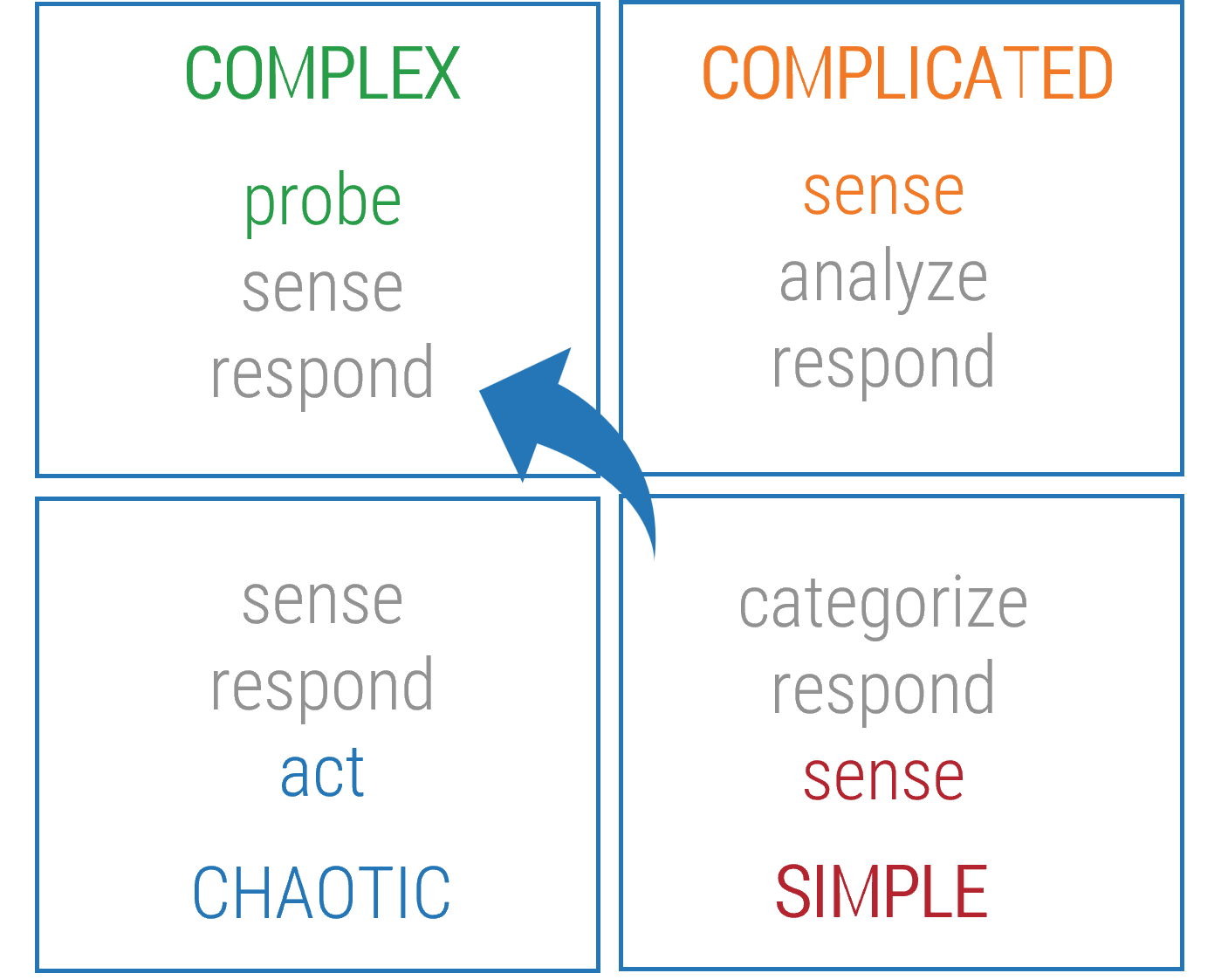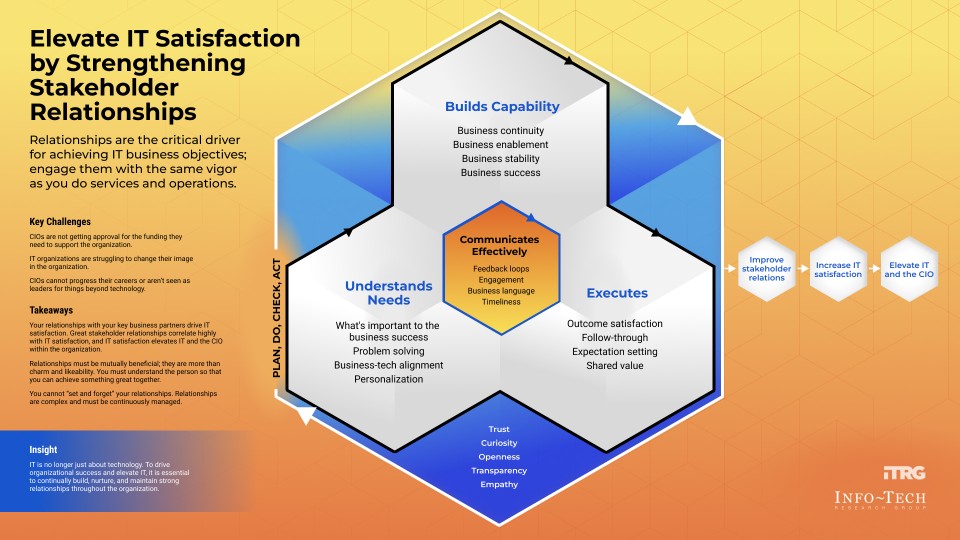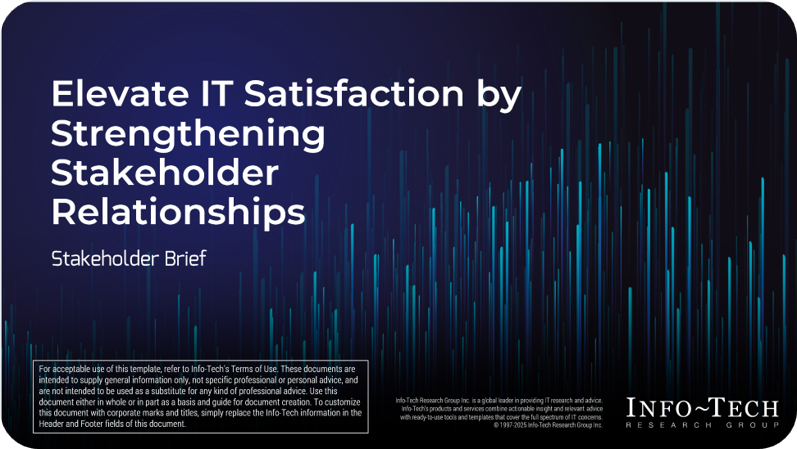Relationships drive IT satisfaction more than you might initially realize. Indeed, relationship satisfaction is so highly correlated with overall satisfaction with IT, that CIOs should focus on stakeholders with the same vigor they have for IT operations or IT services. In fact, neglecting stakeholder relationships can weaken even the most well-managed IT departments. Use this research to transform your relationships with stakeholders in order to drive IT satisfaction and success.
According to data from Info-Tech’s CIO Business Vision Diagnostic, relationships drive business satisfaction with IT more than applications, innovation, infrastructure, and even capacity. This makes sense because people, not technology, decide how to fund the IT department; people, not technology, influence your career progression; and people, not technology, help you deliver on mandates and complete objectives. People, not technology, make the real difference for IT.
1. Focus your efforts.
First, prioritize your stakeholder relationships. Identify and select the stakeholders who make the most sense to focus on. But revisit your priorities regularly to shift your focus along with your organization’s context.
2. Understand stakeholder needs and wants to drive focused value.
Relationships that deliver on organizational objectives move beyond the surface of things. It is not about being charming and likeable or about making wish lists. It’s about truly understanding your stakeholders’ wants and needs so that you can partner and deliver something great together.
3. Apply continuous improvement to your stakeholder relationships.
Relationships exist in a complex web of interactions within a complex organization that sits within a complex world. Leaders need to adopt approaches that allow them to continuously engage, understand, and appropriately respond to new information – about the world around them and their stakeholders – as it is learned. Adopt a continuous improvement mindset that helps you stay focused on your goals while affording you the opportunity to pivot where necessary.
Use our in-depth blueprint to transform your relationship with stakeholders and improve IT satisfaction.
Use this blueprint, along with key tools and templates, to identify and transform your working relationship with key stakeholders. By engaging stakeholders in a meaningful way and building allyship, you can enable your IT team to achieve key organizational objectives, increasing satisfaction with IT and elevating both IT and the CIO within the organization.
- Identify stakeholders that you need to focus on now but be prepared to shift focus in response to changing contexts, events, and needs.
- Understand your stakeholders through key relationship areas: communicating effectively, understanding needs, executing requests, and building capabilities.
Member Testimonials
After each Info-Tech experience, we ask our members to quantify the real-time savings, monetary impact, and project improvements our research helped them achieve. See our top member experiences for this blueprint and what our clients have to say.
9.0/10
Overall Impact
Client
Experience
Impact
$ Saved
Days Saved
Department of Finance
Guided Implementation
10/10
N/A
N/A
Excellent, sound advice provided by Patti - thank you! She also provided valuable feedback to the grad team on their final report. Great service - ... Read More
Department of Local Government, Water and Volunteers
Guided Implementation
8/10
N/A
N/A
Allison was extremely knowledgeable and very quickly pivoted to address the nuances of this area that I wanted to focus on, ensuring the broader co... Read More
Elevate IT Satisfaction by Strengthening Stakeholder Relationships
Technology is easy. People are hard. Stop dismissing stakeholder relations as a charming “soft skill” and instead recognize it as a critical driver for achieving business objectives.
Analyst perspective
Treat stakeholder engagement as seriously as operational sustainability or service excellence.

If you want to improve your organization’s satisfaction with IT and elevate both IT and yourself, stakeholder engagement must be as urgent a priority as service delivery or operational stability.
Failing to invest in stakeholder relations can undermine even the most well-run services and operations because poor engagement has real consequences. Communicate poorly and you’ll miss out on crucial funding to deliver services that drive organizational priorities. Ignore needs or execute on them poorly and never gain the trust of the organization. Miss the chance to build capabilities with key business partners and forgo the opportunity to connect dots to help bridge the gap between technology and business. On the flip side, engaging and partnering with stakeholders to achieve organizational objectives means you gain trust with your peers, become the trusted advisor all departments rely on, and change the perception of IT from a technology task force to a strategic business partner.
But where to begin? IT satisfaction scores have improved very little over the last ten years (Info-Tech Research Group’s CIO Business Vision, 2021-2025; n=820) most likely because conventional tools and approaches to stakeholder engagement focus on managing stakeholders rather than engaging and viewing them as necessary to secure short-term buy-in. This approach fails to recognize that to really deliver excellent services and operations, you need to build a symbiotic relationship by understanding the person. And people are complex; they operate within a complex web of interactions within a complex organization that sits within a complex world. Simple tools are insufficient.
To engage stakeholders in a way that changes their satisfaction with IT, manage the complexity with a disciplined, continuous approach. Set goals for your stakeholder engagements, measure your progress, and revisit stakeholder lists regularly to address organizational changes and unpredictable external upheavals.
Diana MacPherson
Research Director, CIO
Info-Tech Research Group
Executive summary
Your Challenge |
Common Obstacles |
Info-Tech’s Approach |
|---|---|---|
Traditional approaches to stakeholder management fail to elevate the organization’s satisfaction with IT or CIOs. This is due to:
In short, IT leaders concentrate on technology when they need to focus on people. |
IT leaders experience these challenges because they:
Longstanding biases to stakeholder engagement obscure their significance in elevating IT and the CIO. |
Stakeholder management is a key driver for achieving organizational goals and elevate IT and the CIO to:
|
Info-Tech Insight
To elevate IT's role within the organization, IT leaders must prioritize stakeholder engagement with the same level of urgency and dedication as they do service delivery and operational stability.
Your challenge
Organizational satisfaction with IT is highly correlated with stakeholder engagement, which means …
- If you improve your stakeholder relations, you improve your organization’s satisfaction with IT and ultimately elevate IT and the CIO within the organization.
- Yet, improvements in stakeholder engagement remain flat, increasing marginally by 1% each year, proving CIOs are missing out on opportunities.
Source: Info-Tech Research Group’s CIO Business Vision, 2021-2025; n=820. - IT leaders typically focus on IT operations and service delivery. Even IT leaders who want to engage stakeholders often deprioritize connecting with them in favor of completing operational tasks.
Source: Info-Tech Research Group Time Study, 2024. - When IT leaders do engage stakeholders, they fail to appreciate the context that their stakeholders work in, their challenges, and what matters to them. This keeps the engagement at a surface level, missing the opportunity to collaborate.
The bottom line: If IT leaders want to change the perception of IT in the organization, they need to understand and engage stakeholders with the same dedication they put toward services and operations.
Only 13% of CIO time is spent managing stakeholder relationships.
Source: Info-Tech Research Group IT Staffing Assessment, 2019-2024; n=715 organizations
43% of CIOs spend their time doing operational and administrative tasks.
Source: Info-Tech Research Group IT Staffing Assessment, 2019-2024; n=715 organizations
Common obstacles
IT leaders make mistakes with stakeholder engagements because:
- They carry entrenched biases:
- IT leaders often conflate stakeholder engagement with charm and likeability which means they either dismiss it as trivial or fail to authentically connect with their stakeholders.
- Misapply tools and approaches they were exposed to earlier in their career when they worked on projects. These approaches suit shorter-term initiatives and do not scale well; they rarely consider the need to reflect and adjust your approach as new information arises.
- They are stretched thin:
- Organizations expect IT leaders to provide expertise across all functions, requiring fluency in finance, HR, marketing, and industry-specific areas. Engaging stakeholders takes time and effort that feel extra burdensome to many CIOs and IT leaders, especially if those skills have atrophied over time.
- They use the wrong approach to the problem:
- CIOs and other IT leaders, familiar with improving IT processes, assume that if they focus solely on bettering their operations and service delivery, their IT satisfaction will improve. It may, but most likely not as dramatically as it would if they focused on stakeholder engagement with the same vigor.
Only 3% of IT organizations have a high satisfaction score from their critical organization stakeholders.
Source: Info-Tech Research Group’s CIO Business Vision Survey, 2024
94% of IT employees believe their managers’ skills need to change by 2030 to adapt to the future of work.
Source: Info-Tech Research Group IT Talent Trends, 2025; n=404
Technology is easy, people are hard
- Many leaders make the mistake of tackling the complexity of stakeholder engagement with methods designed for simpler, more predictable contexts.
- For example, they may see stakeholder engagement as a simple categorization exercise, placing the humans they interact with in boxes of perceived power and influence and engaging them based on this perception. While this may work for achieving short-term initiatives, it fails to scale effectively over time.
- To achieve long-term success, IT leaders must acknowledge that stakeholder engagement is complex and intertwined within a never-ending web of relationships. One event (a change in leadership, a merger and acquisition, a geopolitical upheaval) can trigger unknowable ripple effects across the stakeholder network. You must be able to adapt quickly to new information in situations like this and simple categorization methods will not help you.
- Instead, continuously engage, understand, and appropriately respond to your stakeholders’ needs.
Stakeholders are complex. Do not make the mistake of using approaches and tools designed for simple contexts.

Source: Harvard Business Review, 2007
Info-Tech’s approach

The Info-Tech difference:
Don’t miss your chance to reshape how your organization perceives IT:
- Target stakeholder relations in the areas that make the most difference: communications, understanding needs, executing requests, and building capabilities.
- Adopt a continuous approach designed to scale and endure as stakeholders and circumstances change and evolve.

Leverage a continuous improvement approach
This allows you to adjust to new information and absorb disruptions.
- Stakeholder engagement is not “one and done.” Changing internal or external circumstances may require a reevaluation of your list of stakeholders or stakeholder focus. New information about stakeholders, or how they react when you engage them, may require adjustments to your approach.
- These adjustments “as you go” are only successful if you:
- Continuously revisit stakeholder plans and briefs.
- Reflect at set intervals.
Stakeholder engagement is continuous and requires set reflection intervals so that IT leaders can adjust to new information or disruptions and still meet their stakeholder goals.

“ … even after a year or two … I think I know all of their opinions, (but) in one session they can say something that I just did not expect, that I absolutely would not have attributed to them. And that’s been a constant experience for me … realizing that people are complicated human beings.”
– Julie Sedivy, Clear+Vivid with Alan Alda, 2025
Info-Tech’s methodology for stakeholder engagement
1. Identify goals and stakeholders |
2. Understand your stakeholders |
3. Build your action plan |
4. Track progress and maintain focus |
|
|---|---|---|---|---|
Activities |
1.1 Articulate goals 1.2 Identify primary stakeholders 1.3 Identify hidden stakeholders 1.4 Determine who to engage |
2.1 Create stakeholder profiles 2.2 Build your relationship 2.3 Communicate effectively 2.4 Understand stakeholder needs 2.5 Execute requests 2.6 Build capabilities |
3.1 Set up your action plan 3.2 Identify objectives 3.3 Articulate success 3.4 Determine outcomes |
4.1 Reflect on stakeholder engagement 4.2 Build your pulse survey 4.3 Identify focus hacks |
Activity Outcomes |
Articulated goals for investing time into stakeholder engagement that later steps will align to. Identified stakeholders CIOs can focus engaging now, next, and later. |
A profile for each stakeholder for reference when engaging individual stakeholders. |
An action plan for engaging each stakeholder complete with expected objectives and expected outcomes at set intervals. |
Experience completing a reflection to gauge progress toward objectives. A method to track progress toward goals. Methods to maintain focus and deliver on commitments. |
Insight Summary
Overarching insight
Stakeholder relationships are the critical driver for achieving IT business objectives; engage them with the same vigor as you do services and operations to improve IT satisfaction and elevate IT and the CIO.
Insight 1 |
Prioritizing one stakeholder relationship to improve over another does not mean you are abandoning the other stakeholders. It simply reflects which organizational priorities are most essential right now. |
|---|---|
Insight 2 |
Understanding what stakeholders want (and more importantly, what they don’t want) requires knowing their business and the circumstances underlying their priorities and behaviors, and although you need to “speak their language” you do not need to be fluent. |
Insight 3 |
Plans are necessary but not forever. Plan to adjust your plan to accommodate changing circumstances and new ways of engaging stakeholders. |
Insight 4 |
Stakeholder engagement is not “fix it and forget it.” Relationships are complex and must be managed continuously. |
Blueprint deliverables
Each step of this blueprint is accompanied by supporting deliverables to help you accomplish your goals.
|
Articulate your stakeholder management goals, track your stakeholder relations trends, identify your stakeholders, and document your objectives, observations, and interactions with each stakeholder.
|
Build an action plan to engage your stakeholders by identifying your goal with the stakeholder and creating objectives and outcomes to achieve it.
|
Blueprint benefits
IT Benefits |
Business Benefits |
|---|---|
|
|
Measure the value of this blueprint
Improving stakeholder satisfaction with IT is undoubtedly the main objective of strengthening the relationships IT leaders have with their various partners both internal and external to the organization. However, there are several benefits that any IT leader could acquire by completing this blueprint:
Measurable benefit |
What to measure |
How to measure |
When to measure |
|---|---|---|---|
Business leaders see CIO as a connector of dots that helps bridge the gap between technology and business. |
Business leaders consult the CIO/IT more often for advice on enterprise business opportunities, risks, and solutions. |
Baseline the number of times the CIO is asked for business input into business opportunities, solutions, risks. Measure again and subtract the difference. |
A month after stakeholder engagement work begins. |
Satisfaction with IT improves throughout the organization. |
Stakeholder sentiment with IT improves in the areas of communication, understanding needs, executing on requests, building capabilities (training). |
Pulse survey using questions included in Step 4 of the CIO Business Vision Diagnostic. |
Monthly pulse for survey. Annually run the CIO business vision diagnostic. |
Strong stakeholder relations build allyship and increase the sphere of influence for the CIO/IT leader. |
Lines of business include the CIO/IT leader when they are meeting with their stakeholders. |
Baseline the number of times IT is asked to join enterprise/business meetings with customers. Measure again and subtract the difference. |
A month after the work is complete and the outcomes are reached with each stakeholder. |
Executive brief case study
Poor stakeholder engagement has real consequences.
INDUSTRY: Higher Education
SOURCE: Research Interviews
Results Communicating to the right stakeholders about the right things (outcomes, not technology) makes a huge difference on how the organization views IT. |
The IT leaders of a higher education institution needed to expand their network to support a growing campus while maintaining operational stability at their existing sites. As had been the process for years, the CIO needed to request funding each year to support network operations. The funding pool financed several initiatives and there was little to spare for IT operations. Each year, IT ran out of funds, unable to meet the network demand with so little money. Over time, locations experienced network holes and the university community felt IT just couldn’t deliver on basic needs. Yet IT could deliver! They were highly capable, but the problem was the funding model. The current IT leader did not understand available funding options or engage the CFO to help identify new ones. When they did engage administrative colleagues, they spoke only in technical terms about what needed to be done to support the network infrastructure. Things improved only after a new leader met with the CFO to understand the funding options to do what IT needed to do. They then met with the appropriate stakeholders who could approve a different funding model once they understood that the funding was too limited and why. A different funding source and model was implemented, and IT was able to expand the network and provide excellent network stability shortly after. Not engaging the CFO and administrative bodies to clearly communicate what IT needs to address a crucial business need has real consequences for how IT can deliver and how IT is perceived. IT may have the best people, processes, tools, and services but they may not be as great as they could be if they do not engage their stakeholders. |
Info-Tech offers various levels of support to best suit your needs
DIY Toolkit |
Guided Implementation |
Workshop |
Executive & Technical Counseling |
Consulting |
|---|---|---|---|---|
“Our team has already made this critical project a priority, and we have the time and capability, but some guidance along the way would be helpful.” |
“Our team knows that we need to fix a process, but we need assistance to determine where to focus. Some check-ins along the way would help keep us on track.” |
“We need to hit the ground running and get this project kicked off immediately. Our team has the ability to take this over once we get a framework and strategy in place.” |
“Our team and processes are maturing; however, to expedite the journey we’ll need a seasoned practitioner to coach and validate approaches, deliverables, and opportunities.” |
"Our team does not have the time or the knowledge to take this project on. We need assistance through the entirety of this project.” |
Diagnostics and consistent frameworks are used throughout all five options.
Guided Implementation
What does a typical GI on this topic look like?
| Step 1 | Step 2 | Step 3 | Step 4 |
|---|---|---|---|
Call #1: Scope requirements, objectives, and your specific challenges and identify goals. Call #2: Identify stakeholders and focus your relationship building on those top stakeholders. |
Call #3: Identify your stakeholder needs and discuss their communication approach. Call #4: Articulate how IT is delivering against requests and enabling the organization. |
Call #5: Define goals for each stakeholder and relationship objective. Call #6: Clarify what success with each stakeholder will look like at your defined intervals. |
Call #7: Reflect on a stakeholder encounter, review pulse survey questions, and identify focus hacks. |
A Guided Implementation (GI) is a series of calls with an Info-Tech analyst to help implement our best practices in your organization.
A typical GI is 5 to 8 calls over the course of 2 to 3 months.
Step 1
Identify goals and stakeholders
Activities
1.1 Describe your stakeholder engagement goals
1.2 Identify your primary stakeholders
1.3 Identify your hidden stakeholders
1.4 Determine who to engage now, next, later
This step involves the following participants:
CIO or equivalent IT leader
Outcomes of this step
- Articulated goals for investing time into stakeholder engagement that later steps will align to.
- Identified stakeholders CIOs can focus engaging now, next, and later.
What do you hope to achieve by engaging your stakeholders?
|
Common goals for stakeholder engagement include:
|
1.1 Describe your stakeholder engagement goals
10-20 minutes
- Open Slide 3 of the Stakeholder Brief.
- If you completed the business vision diagnostic, enter your stakeholder target metrics for each relations area. If not, consider identifying target metrics after you’ve highlighted your goals.
- Refer to the previous slide to help you articulate your goals. It may help to structure your goal using “I want
so that .” For example, I want to change the perception of IT from a reactive department to a strategic partner so that the organization seeks out technology advice from the CIO/IT in key organizational decisions. - Enter your goals on Slide 3. To conserve space, you can start with the verb and not include the “I want.”
| Input | Output |
|---|---|
|
|
| Materials | Participants |
|
|
Download the Stakeholder Brief



 Manage Stakeholder Relations
Manage Stakeholder Relations
 Master the Art of Stakeholder Management in Small Enterprise Environments
Master the Art of Stakeholder Management in Small Enterprise Environments
 Embed Business Relationship Management in IT
Embed Business Relationship Management in IT
 Communicate Any IT Initiative
Communicate Any IT Initiative
 Effective IT Communications
Effective IT Communications
 Elevate IT Satisfaction by Strengthening Stakeholder Relationships
Elevate IT Satisfaction by Strengthening Stakeholder Relationships
 From Silos to Synergy: Create Marketing and IT Alignment
From Silos to Synergy: Create Marketing and IT Alignment
 Take Control of IT’s Narrative
Take Control of IT’s Narrative